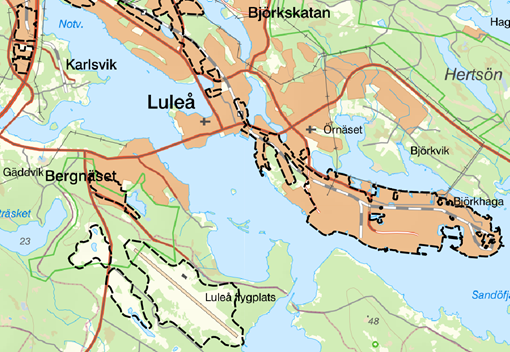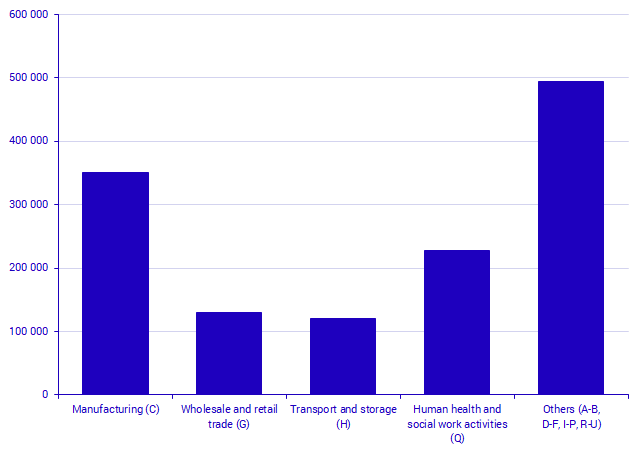Activities Zones 2015
New geographical delimitations of activities zones
Statistical news from Statistics Sweden 2020-11-27 9.30
In 2015, there were 3 400 activities zones in Sweden. They included more than 68 000 local units, in which there were more than 1.6 million employed persons.
Activities zones are geographical areas that contain a concentration of local units or include large scale and industrial land use. An activities zone can include activities such as industry and business parks, colleges, universities, hospitals, or large land areas with airports, mines and quarries. The statistics show how many people work in the activities zones, the amount of land the zones cover, and the number of enterprises and industries contained therein. These statistics can be used as a basis for analyses on the interaction between activities in different industries and their land use, and for physical planning, for example in regional planning and planning of urban development.

Source: Map: © Lantmäteriet (Swedish National Mapping and Cadastral Agency). Activities zones: Statistics Sweden
Manufacturing and health and social care are the largest industries
Four industries are completely dominant among activities zones. Manufacturing and health and social care are the two largest industries, which accounted for almost half, 44 percent, of all employees in the activities zones. Employees in trade and transport and storage accounted for 10 percent and 9 percent of the total number of employees in activities zones according to Statistics Sweden. Besides these four industries, there are employees in 15 other industries. These other industries together accounted for 37 percent of the total number of employees in the activities zones.

Source: Statistics Sweden
More than half of the employees were in metropolitan counties
In 2015, there were just over 1.6 million employees in the activities zones. More than half, 56 percent of these persons were employed in one of the three metropolitan counties Stockholm, Västra Götaland, and Skåne. These counties also noted most local units in the activities zones. The smallest number of local units in the activities zones was noted in Gotland, Jämtland, and Blekinge.
There are activities zones present in all 290 municipalities in Sweden. The largest number of activities zones was noted in the two municipalities with the largest population, Stockholm and Göteborg, in which there are 78 activities zones each. Skellefteå municipality is in third place, with 49 zones.
Industrial estates and business parks predominate among activities zones
The activities zones are divided into five different types of zones. The “zone with industry, business parks, technical facilities and logistics” type of zone is completely dominant in terms of the number of activities zones. There are 3 036 such zones, which corresponds to 89 percent of all activities zones.
| Type of zone | Number of activities zones |
|---|---|
| Zoological gardens and recreational fairs | 11 |
| Airports | 54 |
| Zone with higher education and health care | 173 |
| Zone with industry, business parks, technical facilities, and logistics | 3 036 |
| Quarries and mines | 130 |
| Total | 3 404 |
Source: Statistics Sweden
Largest land area with activities zones in Gällivare and Kiruna
While metropolitan counties have the largest number of employees in activities zones, in part other municipalities have the largest land area dedicated to activities zones. The largest land area with activities zones, 6 800 hectares, was noted in Gällivare municipality, followed by 4 900 hectares in Kiruna. A considerable proportion of the land area with activities zones in Gällivare and Kiruna consists of quarries and mines and the type of zone that contains industry, business parks, technical facilities and logistics. The third largest land area with activities zones, 3 600 hectares, was in Göteborg, in which activities zones of industry, business parks, technical facilities and logistics are dominant, although there are also considerable numbers of zones of higher education and health care. Large land areas with activities zones are also present in municipalities such as Gotland, Luleå, Malmö, Borås, and Skellefteå.
Open geodata
Activities zones benefit from analysis using GIS (geographic information systems). Download the GIS layer with polygons for Statistics Sweden’s activities zones (in Swedish): SCB:s öppna geodata
Definitions and explanations
At Statistics Sweden, activities zones refers to geographical areas characterised either by a concentration of local units (cluster formation) in the zone, or by large scale and industrial land use in the zone, which has at least one local unit. An activities zone measures at least 3 hectares.
Statistics on activities zones are reported by industry using the Swedish Standard Industrial Classification (SNI 2007/NACE Rev. 2), based on the local units included in the activities zones. Activities zones constitute a supplement to Statistics Sweden’s retail trade areas and these two types of areas do not overlap.
These statistics can be used as a basis for analyses concerning the interaction between activities in different industries and their land use, and for following the geographic footprint made by different activities over time. The activities zones also facilitate studies and analyses of geographical concentrations within various industries, known as cluster formations. In addition, these statistics can form the basis of physical planning, for example in regional planning and planning of urban development.
Statistical Database
More information is available in the Statistical Database
Feel free to use the facts from this statistical news but remember to state Source: Statistics Sweden.
